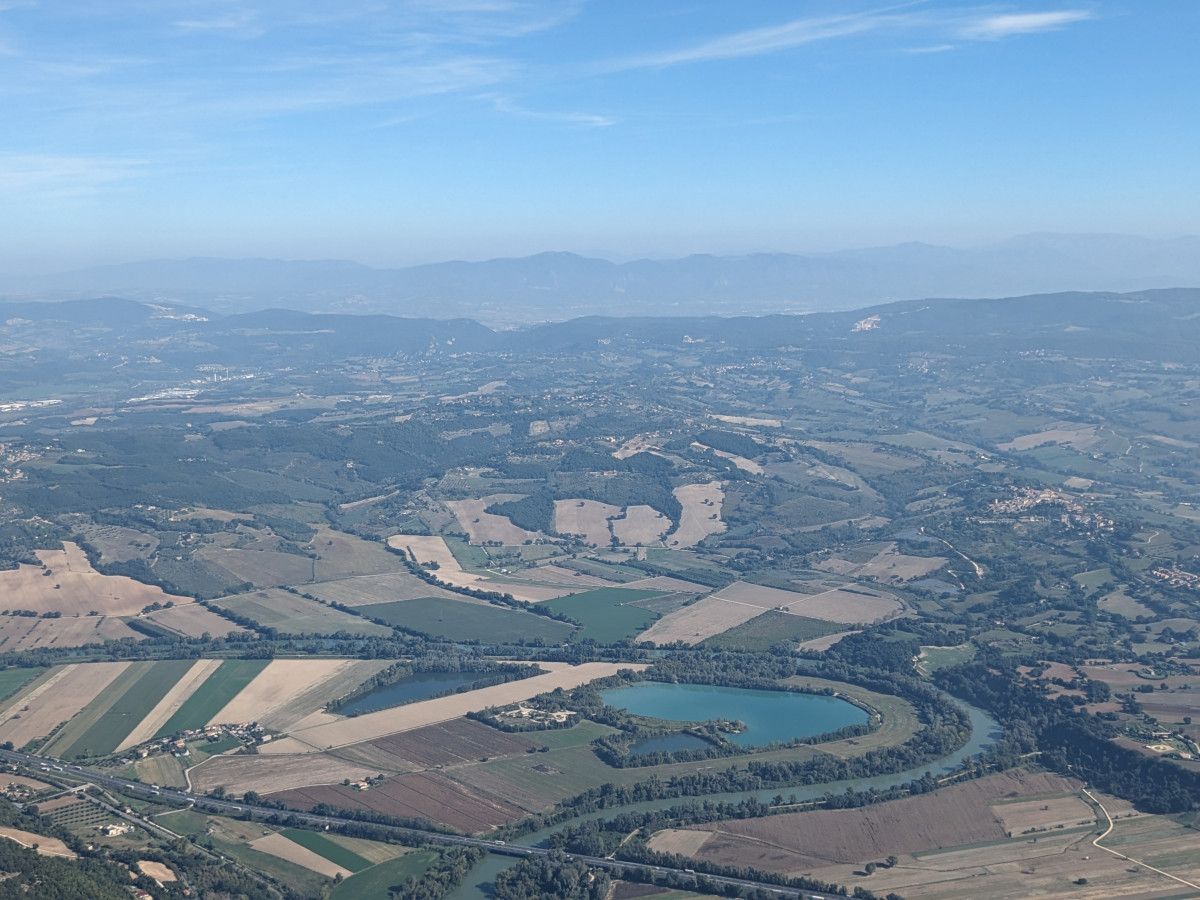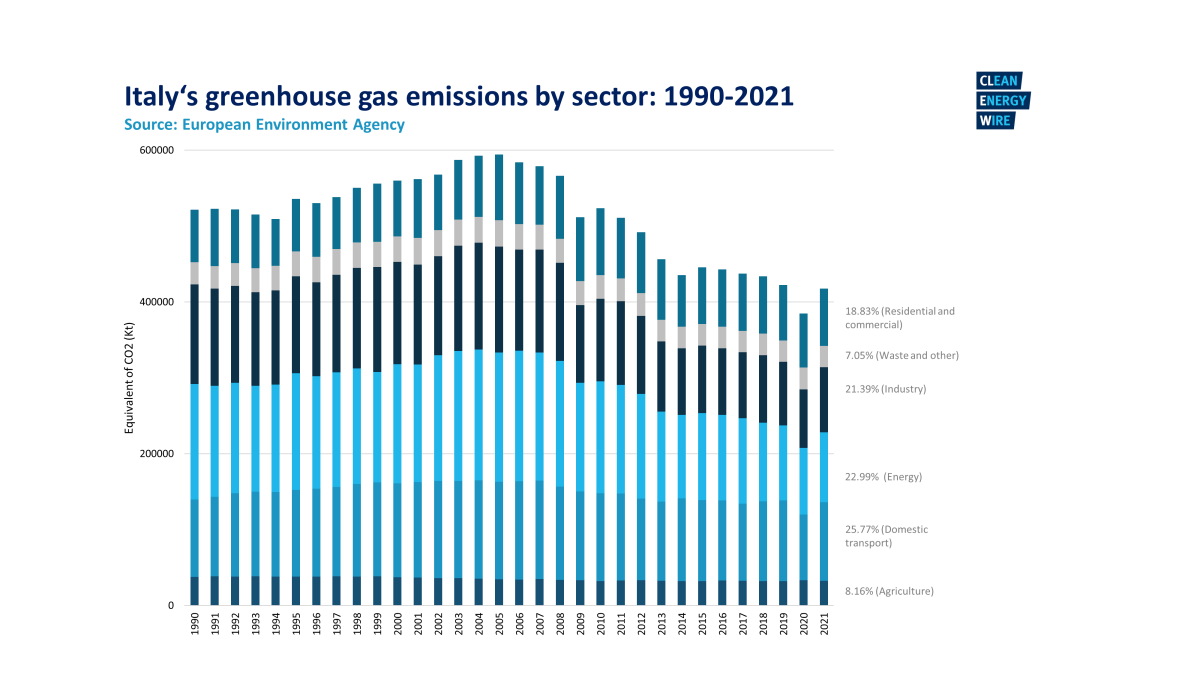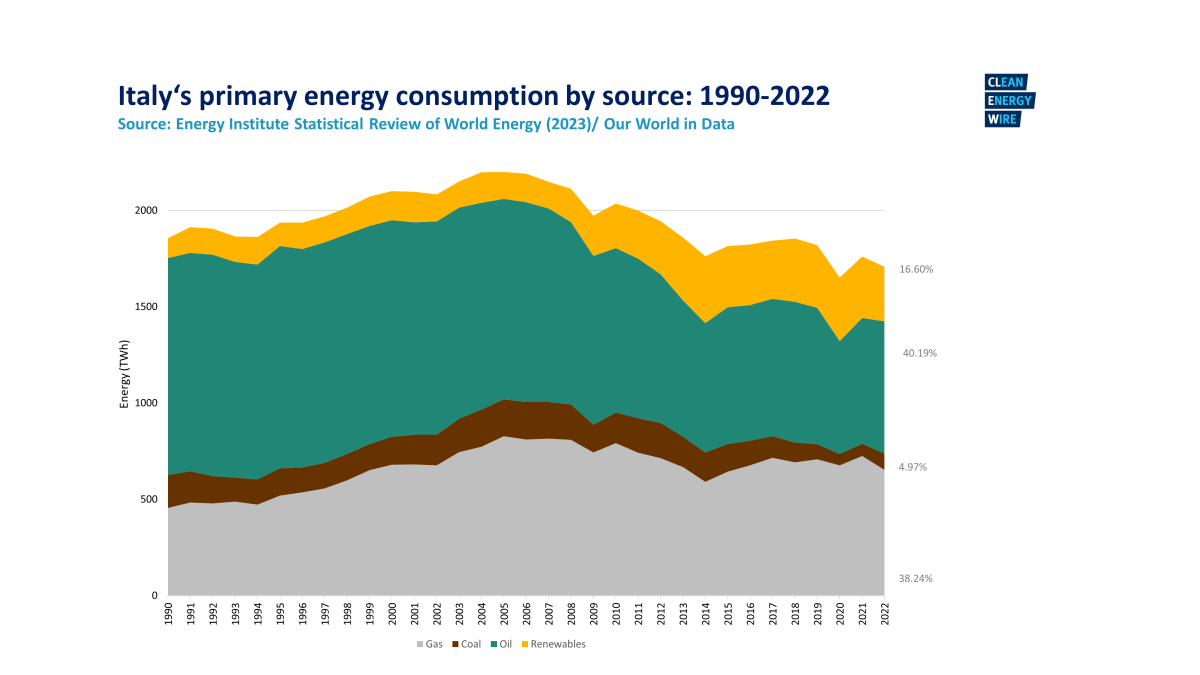CLEW Guide – Italy moves on green transition, but fossil ties remain tight
With its “CLEW Guide” series, the Clean Energy Wire newsroom and contributors from across Europe are providing journalists with a bird's-eye view of the climate-friendly transition from key countries and the bloc as a whole. You can also sign up to the weekly newsletter here to receive our "Dispatch from..." – weekly updates from Germany, France, Italy, Croatia, Poland and the EU on the need-to-know about the continent’s move to climate neutrality.
Content:
Key background
- Italy is the second largest manufacturer in Europe. Besides agricultural goods production, it ranks 2nd in Europe in the number of enterprises in the microelectronics industry, a key sector for the technological and ecological transformation. It also has a large car industry sector.
- Italy is becoming a strategic gateway to North Africa and the Middle East, especially after the changes in Europe’s energy supply following Russia’s invasion of Ukraine. Algeria now is Italy’s main gas supplier, followed by Azerbaijan, and northern European countries the Netherlands and Norway.
- Most of the country’s fossil energy is imported (78 percent in 2021).
- Greenhouse gas emissions have decreased 20 percent since 1990. Italy aims to become climate neutral by 2050. The country has remained consistently within its allocated emission allowances in the EU effort-sharing scheme and estimates that its planned measures will result in it slightly exceeding the 2030 target.
- Due to the heightened concern about climate change, the European Green Deal and the national energy transition plans should have solid public backing. However, people have a strong distrust of politics, the institutions and the media.
- Analysts say that since the energy crisis 2022, the entire political spectrum in Italy sees renewables expansion as a no-regret measure. At the same time, the three-party government coalition set up in 2022 of Fratelli d’Italia, Lega and Forza Italia is focussing on becoming a “gas hub” in the Mediterranean Sea in order to secure energy supplies and diversify sources. Experts say this could delay efforts to decarbonise the energy system and put climate targets at risk.
- The debate on nuclear energy has flared up again in Italy, driven by the current government coalition, which sees nuclear as an energy source that can accelerate decarbonisation. The country closed its last nuclear power plant in the 1980s.
- Europa Verde, (Green Europe) a political party with a focus on climate-friendly transformation, had no representation in Italy’s parliament for 14 years. In the 2022 election, it re-entered, but won only a couple of seats.
- The country’s steps toward climate neutrality laid out in the National Energy and Climate Plan (NECP) remain vague, according to think tank analysts and climate activists. Italy has submitted a draft update of the plan to the EU.
- By summer 2023, Italy emerged from both the pandemic and the energy crisis relatively unscathed. As in the rest of Europe, mild temperatures, savings, energy efficiency and the quest for alternative energy sources– especially from North Africa - have prevented shortages, and the state supported businesses and citizens grappling with rising prices and high energy bills.
- The energy crisis and the widespread droughts in recent years had caused a contraction of the share of renewables in electricity production, mainly due to the sharp drop in hydroelectricity generation. However, hydroelectric production has returned to historical levels thanks to an increase in precipitation which, in 2023, exceeded the historical average, following over 16 months of severe drought (2021-2022).
Major transition stories
- Mattei plan – Italy's government has presented a plan focused on energy and migration cooperation with Africa, the so-called “Mattei plan” (Piano Mattei), named after the founder of Italian energy group Eni, Enrico Mattei. The plan is part of the efforts to turn Italy into a major energy hub, distributing gas from North Africa and the Mediterranean to the rest of Europe. The official launch of the plan occurred on 28 – 29 January during the Italy-Africa Summit. It encompasses five main policy pillars: education and training; agriculture; health; water; and energy. Italy said it would set aside 5.5 billion euros, including 3 billion euros from the climate fund established in 2021 to support international environmental projects. Observers criticise that the plan has been "crafted to advance the traditional goal of access to fossil fuels”.
- Climate protests – Following the large success of youth protests in 2018, more and more activists are trying to enter politics in city councils and other institutions. Before the 2023 elections, Fridays for Future Italy proposed to political parties a Climate Agenda – a plan to address the transition in energy, mobility and certain other fields. Road blocking crime has been included in the 'Security package,' aimed at targeting climate activists. Now, there is a risk of up to two years of imprisonment for those who block a road in an organized manner. The new regulation by the government appears explicitly designed to punish and discourage roadblocks by climate activists.
- Just transition – In Italy, there is a fierce debate about how not to leave anyone behind in the transition to climate neutrality. Certain political leaders, among them the former minister for ecological transition Roberto Cingolani, said they preferred a slower transformation to a "bloodbath" for some people. Buying an electric car, renovating buildings in order to make them more climate friendly, or dealing with higher fuel costs affects everyone, but low-income households as well as workers in the traditional industrial sectors might need support to cope with the changes.
- Climate neutral products and companies – Numerous companies are trying to convert to innovative and climate-friendly production. However, they have costs, bureaucracy, and a shortage of skilled workers to deal with. In Florence, - as an example - workers at the GKN auto parts plant staged a long factory occupation to demand a new industrial model, which combines workers’ rights and new skills that are useful in a just transition.
- Lawsuits against fossil fuels –Greenpeace Italy, ReCommon and 12 Italian citizens are suing ENI, the economy and finance ministry, and the Italian development bank Cassa Depositi e Prestiti, as shareholders for damage – past, present and future – caused by climate change “to which society has significantly contributed by its conduct over the past decades, while being aware of it”. The NGOs have declined ENI's mediation request concerning a possible defamation lawsuit which the company aims to bring against Greenpeace Italy and ReCommon. A second climate lawsuit, against the Italian State, was dismissed in March 2024 when the judge said there was no legal ground for an NGO (A Sud) to ask the State to cut emissions.
- Climate foreign policy – Under the former government led by Mario Draghi, Italy positioned itself as a credible partner in international climate talks, despite shortcomings at home. It hosted the 2021 G20 summit in Rome, with one focus on climate. Now it plays a more marginal role, often criticising the European measures. Its focus has shifted to securing gas deliveries from Algeria, Egypt and other countries in North Africa. It remains to be seen how this will affect the Italian G7 presidency in 2024, or its positioning during the UN climate change conference COP28.
- Adaptation –Italy’s first climate adaptation strategy was published in 2018, but it was officially adopted only at the end of 2023, after a long process of approval and review that showed how climate adaptation is undervalued in the country. The final text was widely criticized by the scientific community, which said it lacked a clear list of priorities, as well as enough funding to be implemented.
- Carbon removal – Forests and wet peatland are among the natural carbon sinks that exist today. The National Recovery and Resilience Plan foresaw the planting of six million trees. However, several cities, such as Milan or Rome, have failed to implement a strategy to achieve this goal. Regarding technological carbon removal and storage solutions, Italy is slowly making efforts. It carries out tests and publishes studies: Eni, whose shareholders include the government, has a project to store CO2 in depleted gas fields off Ravenna with the aim of decarbonising the country's industrial areas.
- Raw materials and recycling – The energy crisis fuelled by Russia’s war against Ukraine and the need for fossil-free energy have pushed the dependence on imports of key raw materials back to the top of the debate in Italy and Europe. The government is working on a circular economy strategy and a China strategy. The EU is working on a raw materials act. Italy ranks first among the top 5 EU economies in terms of waste recycling – both urban and special - with 83.2 percent (2020), above the EU27 average (39.2 percent). In 2023, an estimated 11 million tonnes of packaging will be sent for recycling.
- Seabed drilling – In Italy, seabed drilling is a controversial issue. The seabed stocks more than 90 billion cubic metres of methane and the extraction reportedly costs 5 cents per cubic metre, while importing it would cost 50-70 cents. The public, especially fishermen and farmers, are concerned about the drilling’s impact on the seascape and the associated emissions.
- Subsidies on renewables. After the approval by the European Commission of incentive systems for agrivoltaics and renewable energy communities (RECs), it is estimated that approximately 7.4 billion euros will be unlocked, with a potential new installed energy capacity of over 6 GW.
- Eni, the state-controlled oil and gas company, has unveiled its 2024-2027 investment plan. Oil and gas production will increase: 39% of capital expenditure will go to gas, 21% to oil. Eni plans to get to 8GW of renewable energy in 2027 (from 3GW of 2023). According to the energy and climate think tank Ecco: "The company's decarbonization presents a long-term target-zero net emissions by 2050 that rests too heavily on expensive technologies with uncertain applicability, such as CO2 capture and storage and biofuels, and does not demonstrate a willingness to change the current asset portfolio, which is heavily tied to the upstream sector."
Sector overview
Energy
- Sector was responsible for 23 percent of total GHG emissions in 2021.
- The country’s last nuclear power plants were shut down in 1987, after the Chernobyl disaster. Coal exit is scheduled for 2025. There are no phase-out targets for oil and gas.
- Oil and gas are still the main sources of energy used in Italy, for example in transport and heating, but the share of renewables in overall energy use had increased to 19 percent by 2021. By 2030, 70 GW of capacity is planned to be added.
- Energy community projects are helping the shift to renewables. In Italy, there are only about 100 such projects, but the 2026 target is to install 2,000 MW of renewable capacity with those projects. Since 2021, Italy has been working to promote the creation of so called “energy communities”, but implementation decrees are still lacking, pending the European Commission's scrutiny.
- Hydropower generation, one of the main renewable sources, has been challenged by droughts.
- The energy crisis fuelled by Russia’s war on Ukraine has forced a huge shift in energy supply, and potentially helped speed up the energy transition, but led to LNG buildout and increased gas purchases.
Industry
- Responsible for 21.4 percent of total GHG emissions in 2021.
- Italy is set on saving its industry (e.g. steel, chemicals, manufacturing) by making it climate neutral. One of the main concerns is not to sacrifice jobs in the process.
- After a long period of resistance, some companies are taking on the challenge and are seeing business opportunities in the global net-zero industry race.
- Green hydrogen is seen as key to decarbonising the industrial processes. Italy is trying to convert old industrial areas to produce it through the recovery and resilience plan.
- Few state support programs for green industry, mainly with European funds.
Buildings
- Responsible for 18.8 percent of total GHG emissions, mostly through heating and cooling with fossil fuels.
- Seventy percent of Italian homes are heated with gas, 10 percent with oil, 15 percent with biomass. District heating is not widespread.
- Eighty-one percent of the housing stock were built before 1990, and the renovation rate is very low (0.85 percent per year). The final energy demand of residential buildings has risen in recent years.
- The government has implemented “Superbonus 110 percent,” a subsidy programme worth billions of euros for building efficiency and other programmes for improving heating systems. The programme will end by the 31st of December 2023.
- Government goals: annual building renewal rate of 2 percent in 2030 and 2.6 percent in 2050. Minus 1.9 percent in energy consumption of public buildings; 2030 target: minus 32 percent of GHG emissions.
Mobility
- Responsible for 25.8 percent of total GHG emissions.
- Transport is a key problem of the transition, emissions remained largely unchanged from 1990 until the pandemic hit; sector failed its 2022 climate target; government failed to deliver proposals to get the sector back on track; debate over cabs and other forms of sharing mobility.
- Car-country Italy: car-centric policies; 40 million cars; some municipalities aim to lower the speed limit to 30 km/h in city centres and to ban the entry of more polluting vehicles.
- Italy expects to have more than six million EVs on its streets by 2030 (4.3 million of them battery electric cars).The state subsidises the purchase of electric vehicles.
- Strong misgivings in the public statements from the governing coalition and some automotive companies on the electric transition of private mobility and on the phase-out of diesel cars: they fear a big economic loss; the government boosts biofuels.
- Some municipalities. such as Bari,have experimented with free or low-cost public transport tickets.
- Rail development is slow, especially in the south of Italy, with few signs of improvement; too few public transport offers in the countryside.
- Road freight produces 25 percent of transport emissions; volumes growing.
- Few cycle paths and high number of traffic accident victims in some cities, such as Milan.
Agriculture
- Responsible for 8.2 percent of total GHG emissions (mainly methane from livestock farming, nitrous oxide as result of nitrogen fertilisation; excluding LULUCF)
- Emissions have fallen 13.2 percent since 1990.
- Farmlands are responsible for more than 75 percent of agricultural GHG emissions.
Land use, land-use change and forestry (LULUCF)
- Taken together, forests, peatland, meadows and other land in Italy are net carbon sinks (-27.5 million tonnes CO2 equivalent in 2021).
- Climate law projections: minus 36 million tonnes of CO2 emissions by 2030, minus 37 million tonnes by 2040.
- In 2023: forest area has increased by 23 percent since 1990, wetlands by 2 percent, with positive consequences on the emission trends and carbon storage. However, human settlements have also increased 42 percent.
- Environment agency (ISPRA) says the upward trend in emissions is worrying and it is very important to stick with the Paris Agreement target; recent years have seen an increase in net carbon storage in forests.
- 2030 target: minus 35,8 million tonnes of CO2 emissions.
Find an interviewee
Find an interviewee from Italy in the CLEW expert database. The list includes researchers, politicians, government agencies, NGOs and businesses with expertise in various areas of the transition to climate neutrality from across Europe.
Get in touch
As a Berlin-based energy and climate news service, we at CLEW have an almost ten-year track record of supporting high-quality journalism on Germany’s energy transition and Europe’s move to climate neutrality. For support on your next story, get in touch with our team of journalists.
Tips and tricks
- CLEW’s Easy Guide to Germany’s transition with background information and links to key energy and climate data.




